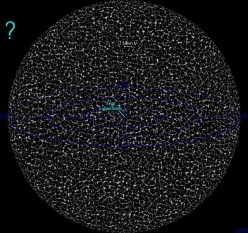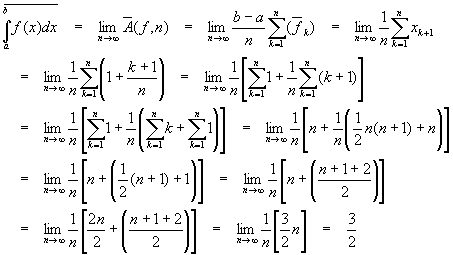What is space?
- jomineposted 14 years ago
0
"Space is the boundless, three-dimensional extent in which objects and events occur and have relative position and direction."; Wikipedia.
If space is a boundless expanse, is it an object or nothing?
If it is nothing[as it lack a shape(boundless], if it has no borders, how does it expand?
How can an unlimited boundless expanse be 3 dimensional? Isn't it the ruler we use , that is three dimensional?
If it is something, can we carry it around, like we carry an object?Actually, what we call "nothing" IS something.
It's called quantum fluctuations which is thought to have caused the big bang seemingly from nothing (which is something).NathanielZhu
I have seen your posts regarding evolution and I say you are a good biologist. With due respect, what you just wrote is nonsense. Space is nothing, that is, it has no shape or borders. It is that which give shape to objects. You can say there are particles. That may be the stars or galaxies or atoms or anything, but the property common to all these are, they have shape. Space is boundless and border-less, objects exist in space or not, it will remain so.
Big bang says everything started from nothing, self creation or creation ex nihilo, either of which is idiotic. Nothing cannot suddenly attain length, width and breadth to be something, similarly something will never loose all these properties to be nothing. If anybody argue so, then they are talking religion not science.NathanielZhu,
If you wish to more clearly understand the positions taken by certain members of this discussion, then I would suggest you read a few of billgaede's hubs. The idea of this topic falls roughly in line with the reasoning proposed in those hubs.This something called space is, from what we know, a vaccuum that does contain electromagnetic radiation in the least, and probably so much undiscovered :stuff" too.
The definition of space is quite contradictory. So, I will recommend to search in a good way about the proper definition of space, understand its properties & then remarks.
In my opinion space can't be defined. It is endless or just an illusion. Only the creator of this knows what is this actually?
jomine:
To define the word "space" is like trying to define the metaphysical.
All anyone can offer is an opinion.
If there are no objects in a 3-dimensional expanse, what is the expanse?
It's like trying to visualize and describe how far do "out and in" go.
It can't be done except as an "opinion" which has no basis in knowing and understanding.
QwarkThe word is not similar to 'god" Qwark! Everybody has to use it if they have to refer what is outside of earth.
Space is nothing but our conceptualization of nothing. When we say space we actually mean nothing or that which has no shape, but give shape to objects!Jomine:
WEll, thank you for re-wording my response. :
:
"Space" can't be defined in any form but opinion.
"God?"...I have no idea what you are referring to..?? :
:
Qwark"Space" can't be defined in any form but opinion.
If it is just an opinion it can never be used in scientific dissertations. Nobody should say space has 4 or 5 dimensions!!
But try this, get a paper(any color you choose), then get a pen of the same color(I meant the ink). Then draw a circle on the paper without making a pressure mark. Then after sometime check the paper. I bet you will not be able to identify the circle you draw. If it has to be identified it has to have a different color. Similarly an object can be identified(thats it shape can be delineated) only if there is a background of nothingness to define the shape. I guess we can call, anything we want, but by convention it is called "space".
"God?"...I have no idea what you are referring to..?? :
:
Neither do I! You are the one who uses that more than I!...again Jomine, naught but an opinion...
 :
:
The world of metaphysics is but, at this moment in human evolution, a land under the bridge where the "troll" lives. :
:
QwarkYou are reading too much relativity Qwark, They are the people who delegate stuff to philosophers, that which they cannot describe by their equations!
I have nothing too do with metaphysics, I'm bored with the esoteric.
I say only with respect to physics. What philosophers or the religionists worry about, is entirely their concern, not mine.
...can't debate that with ya my friend!
I'll stick with, what at the moment is,.."reality." :
:
QwarkReality?
Its very simple Qwark, there are somethings that exist, we human beings try to explain that, try to make a meaning out of it(and some, a living out of it )
)
...The final Frontier, these are the voyages of the Starship Enterprise, it's continuing mission to explore strange new worlds and civilizations, to boldly go where no one has gone before.....da da da da da da.....yadda yadda......
- L.K.kiruiposted 14 years ago
0
You see, the problem is non thorough definitions. You know, define A. A is B. Then define B. B is C etc. We reach a point where we ask what is the purpose of definition? Sane people begine by observation then conceptualisation i.e. Having in mind what you observe. When naming then, we MERELY want it such that what you observed will come to mind when the word is uttered.
Now come to mathematics. Define a number? The mathematicians will tell you we don't define it. The reason is actually simple. The meaning of a number is gotten from the real world and mathematician is not allowed in the real world. So when physicists, whose realm is the real world opt to regard a number etc as undefined is where the whole problem comes in. Since the meaning of a number is gotten from the real world, all a physicist need is produce 3 billiard balls and the deal is done. We now understand the meaning of 3. Ie we merely have the picture in mind so that when somebody say 3, the mind redraw the sceene. We call it conceptualisation.
Now come to space, geometry is a real world discipline. Where definition in words fail, illustration take over or else the word is regarded as meaningless. What is the meaning of 'is equal to?' the mathematician do not define. A physicist? No! He must produce two equal sized billiard balls or else the phrase is meaningless! What is perpendicular? Simple produce a perpendicular line and the deal is done other wise the term is meaningless. What is '3 mutually perpendicular lines?' simple, produce a cube. You see, there is actually nothing called a mathematical meaning! Just because of the definition problem of mathematics. What is 4 mutualy perpendicular lines? A piece of cacke. Just produce a 4 d object and the deal is done or else the phrase is declared meaningless!"What is perpendicular? Simple produce a perpendicular line and the deal is done other wise the term is meaningless. "
Are you arguing that the term "perpendicular" has no meaning in the real world because a truly perpendicular line cannot be produced? If so, then I am bound by academic integrity to inform you that a perpendicular line CAN be produced. Although, I have to admit that I might be missing your meaning entirely (due to your somewhat esoteric use of language).
Unfortunately, I am not a physicist, so I am limited to discussing things from a mathematical standpoint - or, rather, what is actually contained within the generally accepted standard of "mathematics."
I only make that clarification because I note your liberal use of the label "mathematician."
- L.K.kiruiposted 14 years ago
0
The question is not is there two lines that can pass through a point and are both parallel to a third line? Remember that the mathematician has not define line, point and straight. So not short cut the question is what is the meaning of two lines that pass through one point and are parallel to a third line? You see, the mathematicians build the first floor before they build the basement! So a physicist gives us the meaning by simly drawing those three lines. we now then understand that a triangle has two parallel lines or a curve is a straight line and straight line is a straight line so after university, we need to go back to standard one. If he say they meet at infinity, he still need to produce for us infinitely long lines. He is the one saing not us! Otherwise, regard it all as just garbage childish myths of no practical importance in understanding reality.
Ah, one of Mr. Gaede's colleagues?
I only ask this because I notice that you referred to physicists (I presume) as "mathematicians." I will grant that physicists are capable of producing odd results that aren't verifiable in any way, and additionally that they do this frequently using mathematics. However, I would ask that the terms not be used interchangeably, since there are a great many mathematicians who have absolutely no interest in physics (or sometimes even the physical world!) whatsoever.
And, you are mistaken about the definitions of point, line, and straight. Perhaps you haven't looked hard enough? Or, like Mr. Gaede, you disagree with Euclid's definitions.
- Twenty One Daysposted 14 years ago
0
Space is the collective of light, 96% of which --according to scientific studies-- is dark or unobservable. The largest portion of space then would be dominant neutral energy.
James. - L.K.kiruiposted 14 years ago
0
Nathaniel
pleace, set the language correct. Your hypothes is correctly stated as; where we think there is nothing, there is actually something. - L.K.kiruiposted 14 years ago
0
James
we say, in otherwise empty space. There is neutral energy. What is that which you say something? This is the question which has been in my mind. I always think what is beyond the universe?
Who made the first living creature?- L.K.kiruiposted 14 years ago
0
Alisha sharma
yes, it is good that you are giving it second thought. You see, the reason we donnot get pleased is because they tell us that space is nothingness. Then they give it characteristics. When you ask but how. They switch gears and say what we call nothing is something. Someone like you reasonably as; is it the creating spirit of say God you are talking about? They switch back and say no, it is nothing just emptiness, you know, space! How can you make a reasonable debate with such people?L.K.kirui
I agree with you. We are human and can think to a limited extent. We can't compare our knowledge with GOD. Then how can we say that there is nothingness just because we don't know the answer.Again, I can't speak from a canonical perspective on physics, but I would consider "space" to be that which is not occupied by solid (or liquid) matter. For example, the inside of a balloon, to me, is space. I understand that this is not a rigorous definition, but I fail to see why it really NEEDS to be. Is the concept of "space" really that critical to any ideas which you oppose?
The whole effort to undermine mainstream physics through the use of nitpicky semantics frankly reminds me of the attempt by ID/Creationists to dismantle atheism by proving evolution false.
Consider this, L.K.kirui and jomine - if you could get all the physicists in the world to say "space defies our ability to define in a satisfactorily rigorous way," what would you gain? Do you think that such an event would disrupt any current trends in the scientific community regarding physics?Well said, and so true.
I think, aside from pushing an agenda, that the definition needs to be better understood in general. I'm sure physicists understand the concept better than most, but for the rest of us a concrete understanding is essential. Otherwise we will get confused or caught up in semantics, similar to when people think that evolution means that humans came from modern apes, when evolution says that we share a common ancestor.
Of course some individuals will ignore the information provided and not even attempt to rationalize the idea. There's not much you can do to convince a mind that is already convinced it knows everything.mathsciguy
OK, I'll use mathematical physicists, but isn't it a little cumbersome to type?
I think you will agree with me that science is human attempt to explain nature. So all the explanation should be natural. And as it is an explanation that is meant to be conveyed to his fellow beings it should be clear and precise. Hence the need arise to define crucial terms, to convey the meaning consistently and clearly.
Now about space, space is our conceptualization of nothing. Space has no shape, but give shape to objects(it is the background on which objects exist).
As you are a maths guy, you might be well versed in geometry. Hence you might know that dimensions are used only to define the architecture and orientation of an object and they are length, width and height. They are mutually perpendicular and intrinsic property of the object. They are not stand alone, as you cannot have length alone. Even a drawing of line is 2D.
As space is not an object, you cannot put dimensions to space. And as objects cannot have one more perpendicular direction, no object can have more that 3 dimension. So what is this 4th dimension. Such monsters does not exist. Not only that we cannot even conceive or visualize such a thing.
The whole modern science or relativity is based on 4D space and space existing as a road for planets to role around. Hence a rigorous definition itself will destroy the edifice of modern science.
And quantum tells everything is made of particles. They say light is a particle, yet they use wave theory to explain interference and diffraction . You might well know that a mathematical sine wave exist only in paper. In real world it need a medium, and modern science fail to tell what the medium is! The MM experiment discredited the ether theory, yet the very same people say space is made of particles!!!I'm gonna be really honest and just tell everybody up-front that basically what I know about physics beyond simple mechanics I learned from reading Feynman's lectures at CalTech. As you might imagine, this leaves me with what I would consider a better-than-discovery-channel-but-not-nearly-competitive knowledge of topics in quantum physics, QED, etc. But, maybe due to my tendency to take a maths perspective (which I am aware might be entirely improper), I understood the concept of the 4D Minkowski space to be basically like Euclidean space which we normally think of as geometric (height, width, length) but with an added metric of time. For example, a cube in Minkowski space differs from the "same" cube at a different time. But, as I said, my understanding is fairly elementary (at least in terms of quantum theories), so that might be a horrible misconception on my part.
And of course, Riemann came along to show that in Euclidean geometry, parallel lines never meet, an assumption made by Euclid that gets messed up with gravity. His version of non-Euclidean geometry showed they can meet and solved the problem of curved space.

Yes, I do seem to recall that name from somewhere in my past...
Though, I don't really have much experience with non-Euclidean geometry other than transformations of complex functions into a Euclidean frame of reference. And even then, I really am only familiar with the ones that have applications in engineering and modeling.Don't bother about reimann, he is the one who draw a triangle on a sphere with curved lines and claimed the angles together make more than 180 degree, while in actuality a triangle is made of three straight lines!! Another example of 'redefining', very convenient for relativists.
"For example, a cube in Minkowski space differs from the "same" cube at a different time."
A cube left alone will always remain a cube irrespective of any idiots space time. Have you ever seen a circle turn to a sphere by adding the 4th dimension time? The relativists are zombies. They ridicule people who say everything was created by god and put forward a worse nonsense - everything was self created, that is nothing suddenly attained length, width and height to become something!! To add to that, they say nothing was also created along with their bang, that is "nothing" was there before the bang, even "nothing"!Right you are, jomine. I was trying to clear up what seems to be a common misunderstanding about "4D objects." I think people have a tendency to think of it in a sort of Flatland sense, where adding the 4th dimension ends up giving you some kind of inconceivable object like a hypercube, or whatever. This, I think, is not what is meant by physicists referring to the 4 dimensions. Coincidentally, I think that your conception of 4D actually is more in line with what a mathematician would think of - so, perhaps, you really ought to be saying "mathematician" instead of "mathematical physicist."
But, from what I understand, the physicist means something different when referring to 4D. The cube is still just a cube, it looks exactly the same and still has all the same Euclidean dimensional measurements. It may be, in fact, the exact same cube - BUT, remember that "dimension" really only means a metric by which something is measured. The physicist measures the time at which the cube is, as well.
For example, say I have a 3D cube that we'll call cube A. Its measurements are (3,3,3), or 3 high, 3 wide, and 3 long. In 4D we might say that it is (3,3,3,1), or 3 high, 3 wide, 3 long, and 1 second later than a given time. Obviously, the cube won't suddenly become a circle - when we "add" a dimension, we aren't actually changing the object itself but rather are just measuring one more aspect of it.
A final clarification that may help - a line can be a 3D object, as well. Suppose we have a line AB that has measurements (3,0,0). Well, it's still a line - but we've measured it on 3 axes and can see that (since it is, after all, a line) it simply has 0 width and height.
Now, anyone with actual rigorous training in physics please correct me if this is totally off-base, since my understanding may well be imperfect. I am self-taught in this area, so if anyone could verify that this is accurate, I'd appreciate it for my own self-confidence too!
"A final clarification that may help - a line can be a 3D object, as well. Suppose we have a line AB that has measurements (3,0,0). Well, it's still a line - but we've measured it on 3 axes and can see that (since it is, after all, a line) it simply has 0 width and height."
We are in agreement in most respects, though there are some disagreements. When we say '0' D than means there is nothing in that dimension. A line has at least 2 dimensions. A 1D line can never occur, the 2nd dimension may be infinitesimally small, but still it is there. That is the problem when relativistis say '0'D objects. If all dimensions are '0' then what is left is nothing, as 0D has no shape, and is not even conceivable.
The same problem occurs when they try to add concepts like time and space as dimensions. Time is our concept of two locations of an object. With time what changes is the location. We use co-ordinates to denote location and not dimensions. Relativists use all these interchangeably and claim an object has so many dimensions. Since they do not stick to definitions and always change there goal posts, it can never be falsified!You see, this is where my tendency to see things from a mathematics perspective influences my understanding of the topic - really, anyone who could tell me that it's different from what I'm saying, please do because I am not sure if I'm presenting it correctly.
Anyhow, I think that I see where the miscommunication is occurring. When you speak of the "dimension" of an object, you are referring explicitly to the minimum number of measurements needed to uniquely identify the object - although I think you may have meant to call a line a 1D object that cannot be "fit" into 0 dimensions (since a line does, in fact, have 1 dimension - length). But even so, I still don't see the problem with something having 0 dimension - 0 length, 0 height, 0 width (ignoring the measurement of time at which the thing is). I suppose it is difficult to think of it being an "object" since it doesn't actually have measurements.
What things are claimed to be 0D by mathematical physicists? I looked and couldn't find any references to such things, but my search was somewhat limited. After all, if physicists don't claim any physical things to have 0 dimension, then it can hardly be said that the foundations of relativistic physics (or any type of physics, for that matter) are shaken by even the outright assumption of your position as true.Try this,
Draw a line with the finest pen available and then look that line in a microscope, you will see a width. However fine the line is, it still got a width. The moment the width is zero it cease to exist. In fact any drawings are 2D.
Now 0D objects...even electrons are proposed to be 0D, let alone light, the Quanta.... virtual particles. But don't confront a relativist, they immediately change tack! And you will also find that in these particles spontaneously arise from nothing and spontaneously things cease to exist. Usually, only god is supposed to do such magic tricks!So, your basing your knowledge of physics on the size of a ball point pen?
If we use your logic, the line made from the ink from a pen under a microscope would show it actually has three dimensions, length, width and height, so every line should be 3D, and what we consider three dimensional objects in your world would be 9D.

You can prove what you say, very simple, just draw a 1D line. Please explain how that 3D became 9D?
Or are you just telling, all the physics is just wild guesses, with no relation to reality?"If we use your " l "ogic, the line made from the ink from a pen under a microscope would show it actually has three dimensions, length, width and height,"
Just see the " l " in logic, is it 2D or 3D? Can you ever make it 1D?Sure, if I sat there drawing lines on paper and extracting answers, I could make up anything I wanted, just like you.

Oh, I do love a little discussion about infinitesimal values. I see now why you called a line a 2D object. But, strictly speaking, a "line" as is meant in mathematical terms is not what you described. It's a little akin to saying that dogs don't have fur because hey-look-over-there-it's-a-dog-without-fur and you've actually picked out an elephant.
But, I see your contention now, perhaps. It is true that a "line" in the pure mathematical sense is an abstract thing that I'm sure can't be produced in practice in the real world. However, this doesn't make the concept of a pure line totally irrelevant. For example, in mathematics, a line is representative of strict correlation between two variables with absolutely no variance. This can, and does often, happen in the real world when talking about discrete variables - making the line a useful tool for even applied mathematicians.
Are electrons proposed to be 0D? I thought they had mass... so wouldn't that, by definition, make them infinitely dense? Not a professional physicist here, so please correct me if I am mistaken.Hi,
I very well agree its a useful mathematical abstract. But in physics we are dealing with objects and not concepts. We deal with things that exist, hence we don't use anything less than or more than 3D.
Mass is again a concept, they propose it increase only if it get the velocity of Light. In nature there is nothing called 1D, 2D or 4D and mass is a concept that is not defined, hence a 'fit for all size' with no meaning.Sorry, but who is we? Are you referring to just you? Physics doesn't agree with you at all.

Um, you never really make a lot of sense, dude. And you do seem to have your own "physics" that bears little relation to the physics out there in the world.
"you never really make a lot of sense"
For that you need to have sense. Writing novels and "believing" nonsense is not physics. Physics is about explaining the nature(what is generally known as universe) rationally. Nobody is to invent any new stuff called space time, but merely have to explain, the relation between the objects(which is already there), with out any contradiction and magik. Self-creation is magic, and creation-ex-nihilo is supernatural, neither go with physics.You see, how was that response to me? How did it logically flow?
You don't make sense. How is novel writing relevant? A lot of scientists write novels. The also know how to write clearly and argue logically when they need to.
The fact that space is an area bounded by height, width and depth seems to baffle you, and I just don't know why.I thought you are seconding beel, who is a fanatic blindly following his god einstein.
The novels like relativity, brief history of time....
An area is bonded by a margin, not width or height. Space is an expanse. It has no properties like width or height. If we place a ruler, it is the height and width of the ruler we are calculating, not that of space. I think you might have seen the picture of universe. What is that is outside of this universe?
Where is its length or breadth?
I have put a picture here.
what is that black stuff around the universe? Where does it end? what is the length, width and height of that?
I like this take on dimensions
http://www.youtube.com/watch?v=JkxieS-6WuA
Not sure if it has anything to do with the discussion but I thought it was neat
If you want a scientific definition of space, don't look for it in Wikipedia.
Then give your definition that can be used consistently!
Space is an esoteric physics concept and the layman (me) wants something they can understand and get their mind around. I'm not a physicist, but I'll take a stab it.
Space is a placeholder. A multidimensional (at least 4) placeholder.
Imagine you are typing a long string of digits, a very large number. Occasionally you will type a zero. But zero is not truly a number; it is only a placeholder where a number could be placed.
Expanding the analogy, space is a place where energy or matter could be placed. Any particular spot in space could have energy in it, could have matter in it or could be empty with nothing in it. Even if empty, it could hold something, it just doesn't at this moment.
Current theory holds that space, in our universe, is limited; there is an end, or edge, to it. Neither energy nor matter can exist outside of space as there is no placeholder to occupy. Space is the cup that holds all of the energy of our universe, regardless of the form (matter perhaps) that energy is in.I like this concept as it goes along nicely with what I was taught about the subject. Many people use the term "space" when the really mean "void."
Space has a potential to be exist even if it is not occupied by a single atom. You could stick your hand into it.
A "void" is only an expression, like 0, to give a descriptor for nothingness.
Good post.Thanks. That's how I've come to think of it - a place where something can exist as opposed to a "no-place" where nothing is or can be.
I have to disagree in some aspects.
Dimension- is entirely the attribute of an object, not space, as space has no dimension. If we use a ruler to get the dimension of space, it is the ruler's dimension we are measuring not space's!
Second about borders. Again you are attributing the properties of an object to space. If there is a border, what is it made of? What is outside the border?Space certainly does have dimension. You can't fit a 3 dimensional object into a 2 dimensional space - just try to fit a basketball into the surface of a piece of paper. Try to fit a 2 dimensional circle onto a line. Space must have at least 4 dimensions (counting time) to hold the "things" we are familiar with.
To use your ruler thought; place a ruler on the surface of a piece of paper. It occupies part of that "space" now. You can measure the width and height of that paper but that's all. You cannot tip the ruler up; it is completely connected to the surface of the paper and cannot occupy three dimensional space as we required it to occupy only two dimensions.
Why must there be a physical border? What is the border of a pond? Water ends, dirt begins, but there is no physical separation. There is not, nor can there be, anything outside the "border" of space. At least nothing of our universe as there is no space to hold it." You can't fit a 3 dimensional object into a 2 dimensional space - just try to fit a basketball into the surface of a piece of paper. Try to fit a 2 dimensional circle onto a line. Space must have at least 4 dimensions (counting time) to hold the "things" we are familiar with."
Your are equating dimension with direction we can move!
"Why must there be a physical border? What is the border of a pond? Water ends, dirt begins, but there is no physical separation."
Isn't there? The dirt around gives the pool the space. I didn't mean it should always be space, but for celestial objects it should be space!
"There is not, nor can there be, anything outside the "border" of space. At least nothing of our universe as there is no space to hold it."
But space is the conceptualization of nothing(or what is it?)! There should be something around to say there is a border. Like the pond, if there is no dirt that hold the water, the water will continue too infinity and there will be no pond. When the size of the pond is very big we call it lake and ocean, but still has a border that separate the water from other water!Yes, the first 3 dimensions are something we can move in. #4 is time, where we can only move one direction. There may be more, but we are not equipped to either detect or visualize them.
No. The pond occupies space and is contained by space, not dirt. The dirt simply occupies the next section of space after the pond ends. A fish in the water can see the end of his pond and the dirt beyond it even if it can't go there. The end of space is different.
Space is indeed a conceptualization and can be nothing more as we are not equipped to "see" it. Consider a "pond" in zero gravity; it will be a sphere of water, and no matter how large it will end somewhere due to gravity. Without any physical border; it will simply stop occupying more space. Nevertheless the same fish, now in the sphere of water, can see that there is more - there are physical objects (stars maybe) outside the sphere but still in the same space that the sphere occupies. Different location, but the same space. (Don't get confused with a different definition of space - this space is what holds the universe, not a location).
You are asking for the physical properties of "ether", but that concept is no longer in vogue. There is no "ether" - there is only space, the ability to hold the objects of our universe.
"Space certainly does have dimension. You can't fit a 3 dimensional object into a 2 dimensional space - just try to fit a basketball into the surface of a piece of paper. Try to fit a 2 dimensional circle onto a line. Space must have at least 4 dimensions (counting time) to hold the "things" we are familiar with."
Space is an expanse. There is nothing called 2D or 3D space. We can move any where in space. When you are trying to fit something on to a paper, you are trying to fit that to a plane, not space. Can you visualize 4D? If not, why you think such a monster exist in nature? Time? With time the only event happen is an object change location. It never change any structure. Have you ever seen a circle drawn on a paper become a sphere by attaining or adding the "time dimension"?
"Why must there be a physical border? What is the border of a pond? Water ends, dirt begins, but there is no physical separation. There is not, nor can there be, anything outside the "border" of space. At least nothing of our universe as there is no space to hold it."
Have you seen any pond in the middle of an ocean? Why not? Because there should be something there to separate the water from other water to say that that particular water is a pool or pond. Or imagine a solid sphere with 5cm diameter. What made you say it is 5cm? What gave shape to that? Or do you say it is a sphere inside a sphere, inside a sphere..... If space is nothing, how can there be nothing "outside" nothing? Space is our conceptualization of nothing. It is the nothing that surrounds the something that gave shape to the something and make the something a discrete object.
I said, if you want to know how scientists define space, you should use a source that relates to this, not a wiki. I, personally, don't work in a science that worries about how to define space.
So, about you stop ranting and do a little actual work--go get a definition out of a post-graduate level physics text book so why have some pale trembling hope of having a productive discussion here..
Sometimes we can even define space as the distance between one ear and the other.

Technically speaking, it can be defined as the distance between a politician's ears....

I think my views on the subject can be explained mathematically...

One can therefore deduce ipsofacto from this equation the obvious conclusion that space can be defined by the value of 'X', which as the following equation shows, is easy to find...
Q: What is spaace?

The Easy Answer: The Final Frontier...- Lk kiruiposted 14 years ago
0
Mathciguy,
just because you saw me post in Gaede hubs is what makes you presume that I am talking of mathematicians in the way Gaede does and that has made you not understand my post! I talked of the non-euclidean geometry which is officialy done by mathematicians and not physicists and that is why I said mathematicians and not physicists! Then I didn't say perpendicular lines cannot be produced!
Related Discussions
- 5
Applied Mathematics vs. Pure Mathematics
by mathsciguy 14 years ago
As I'm sure everybody already knows, there is something of a contention between two branches of mathematics - Applied Mathematics and Pure Mathematics. For those who thought that math was just math, here is the distinction: Applied Math involves, as might be expected, the applications...
- 7
G-d is infinite, eternal, absolute, boundless and abstract then, how can he be J
by Neferkaptah 12 years ago
G-d is infinite, eternal, absolute, boundless and abstract then, how can he be Jesus, the Christ?G-d is infinite in size and you cannot increase or decrease G-d, G-d is eternal always the same, G-d is absolute and boundless without limitations, parameters and G-d is unversally abstract, not known...
- 155
Are these people morons?
by jomine 12 years ago
A definition is a sentence that describe the meaning of a word precisely and clearly that the word can be used unambiguously. A definition limits the meaning of a word.A synonym on the other hand is a word with a similar meaning, a word that may be substituted for a given word. It DOES NOT clarify...
- 48
What makes a god a god?
by andrew savage 12 years ago
Oh, my guide. When I was a lot younger I remember two people of the Jewish faith talk about their deity. I remember that they explicitly said that they never refer to their deity as "god," and that when their people first reunited in contact with their creator, YHWH, long after the...
- 28
How does one define self?
by mischeviousme 13 years ago
I have a basic idea as to what I am, a human being with all of the working parts. But what is this "I", which resides within? Am I my name, my job or my title? I know that everything I see is an electrochemical response to light entering my eyes and that every feeling likewise. But who is...
- 3
Who Are Or Were The Greatest Mathematicians That Ever Lived?
by PhoenixV 12 years ago
Who Are Or Were The Greatest Mathematicians That Ever Lived?Who Are Or Were The Greatest Mathematicians That Ever Lived? And specifically what contributions did they make to be thought of as the greatest mathematicians?




















